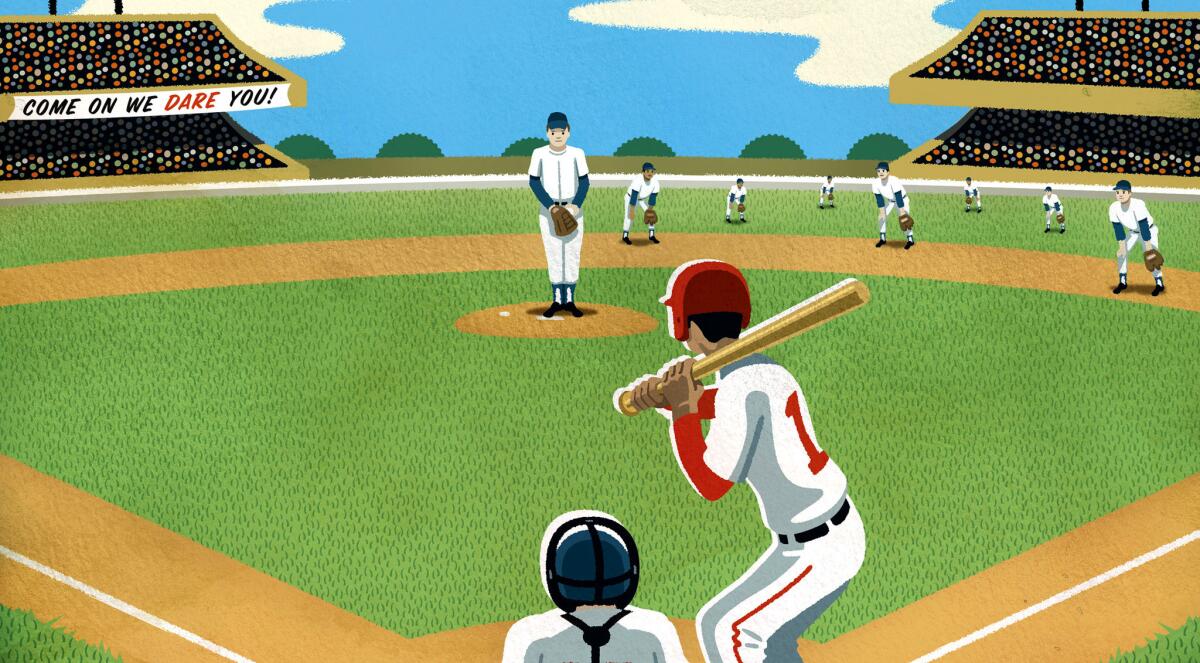Use of defensive shifts in baseball is spreading — because it works

This might be a bit extreme, but baseball teams have increasingly been utilizing infield shifts.
- Share via
It was the summer of 1946, and after being burned by three Ted Williams home runs in the first game of a doubleheader, Cleveland Indians Manager Lou Boudreau devised a plan.
When Williams came to the plate in Game 2, Boudreau stacked his infielders on the right side.
As Dodgers broadcaster Vin Scully recalls, “I thought, ‘Well, that’s the first time I’ve ever heard of an infield overloaded against a hitter.’”
Curious, Scully investigated and, he says, discovered another reference to a shift years earlier. In 1920, Cy Williams had faced an infield loaded to one side.
Not satisfied, Scully dug some more and found an even earlier example. Long before either Williams faced a defensive shift, a manager named Ferguson had moved his second baseman to the shortstop side of the bag against a right-handed hitter.
“So if you’re talking about shifts,” Scully said, “it might go to 1877.”
The strategy might not be new, but the frequency with which it is now deployed is off the charts.
The number of shifts has nearly doubled every year since 2011, from 2,357 to 13,298 last year, according to Baseball Info Solutions. And there has been another spike this season, to 10,262 by the All-Star break.
The decision on whether to use a shift is based on scouting information, statistical data and, in some cases, a manager or coach’s intuition.
Decisions made by the Angels coaching staff based on analysis provided by the club’s front office reportedly was the root of a rift between Manager Mike Scioscia and general manager Jerry Dipoto, which led to Dipoto’s recent resignation.
Dipoto had called a meeting with coaches and the discussion turned contentious when the coaches were asked to do a better job of disseminating the information scouts and analysts were supplying, Foxsports.com was first to report. In another meeting two days later, Dipoto told the players that they would be receiving that information directly from the front office — a change that was not entirely well-received by the players.
The Angels rank 18th among MLB’s 30 teams in number of defensive shifts this season and are among the best in the big leagues in defensive efficiency, ranking fifth overall in converting balls hit in play into outs, according to Baseball Prospectus.
The Angels shift more often than even the Dodgers, whose baseball operation is led by Andrew Friedman, an acknowledged proponent of analytics. The Dodgers rank 26th among major league teams with 185 shifts through the first half. They shifted 208 times all last season.
“We felt like it really benefited us a lot from the prevention side,” Friedman said.
Data indicates the shifts are working throughout baseball. The strategy saved 190 runs in the first half this season, according to estimates from Baseball Info Solutions.
That’s bad news for Major League Baseball executives, who would like to infuse more offense into games. Early this year, first-year Commissioner Rob Manfred went so far as to say he would consider banning defensive shifts.
Among Angels and Dodgers hitters, Albert Pujols and Adrian Gonzalez have faced the most shifts — and the strategy has not been particularly effective against them. Over his career, Pujols’ batting average on ground balls and short line drives has increased by 28 points against shifts. Gonzalez’s average has decreased, but not substantially.
Hall of Fame slugger Mike Schmidt recently penned an op-ed article for the Associated Press in which he argued that hitting coaches needed to start developing hitters who could drive balls to all parts of the field. And some observers wonder why the hitters don’t just bunt or tap the ball away from the shift for a base hit.
But Pujols and Gonzalez share a similar approach: change nothing.
Pujols recalled that during a game in 2003 he succumbed to temptation and tried to bunt for a hit.
It didn’t work — he was an easy out — and later his effort was berated by Moises Alou, a veteran then playing with the Chicago Cubs.
“Good hitters don’t do that,” Alou scolded. “Don’t ever embarrass yourself like that anymore.”
Now Pujols tries not to think about the shift. Besides, he said, he doesn’t have the speed to just slap the ball and run.
But, he added with a mischievous grin, “You never say never.”
Gonzalez said trying to hit singles away from a shift by slashing or punching at the ball changes a swing and is not effective. “If your mind is saying you’re going to hit it that way,” he said, “you know where you’re going to hit it? In the left-field dugout or in the left-field stands” behind the dugout.
“You’re going to be like, ‘Why didn’t I just try to hit the ball hard?’” Gonzalez added.
Gonzalez and Pujols agreed that hitters must accept that shifts will take away a hit on occasion.
For the Dodgers’ defense, the process starts with personnel who analyze batters’ tendencies. They look at spray charts and recent trends. Past matchups against Dodgers pitchers are invaluable. For Clayton Kershaw and Zack Greinke, the data is large enough to get a good sense of where a batter will hit the ball.
There can be pushback, Friedman said, but the team is careful not to control how a pitcher should throw.
“It’s flowing out of our game plan of how we’re pitching to the hitters,” Friedman said.
Dodgers left-hander Brett Anderson said he often doesn’t know how his defense will shift against certain batters. He doesn’t want it to change the way he pitches.
Before each game, Tim Wallach, the Dodgers bench coach, posts charts in the dugout for the infielders to consult. The goal is to take away the largest swath possible.
Invariably, though, some hits find a way through.
When the Dodgers played Atlanta in May, they overloaded the right side against the left-handed-hitting Freddie Freeman, the Braves’ best hitter. In his first at-bat, Freeman took a half swing and accidentally poked Anderson’s pitch past third base for a hit.
The next time up, the Dodgers held firm with the shift and Freeman, buoyed by his earlier success, eyed the same gap and threw his hands in that direction. The ball squirted just foul.
Chastened, the Dodgers shaded more toward a traditional defensive set, and from the mound Anderson caught a smile spreading across Freeman’s face.
Anderson said Freeman was the first batter he’s ever seen try to poke a ball through the opposite side of the infield in response to a shift.
After 138 years, it turns out, there’s still room for surprise.
More to Read
Go beyond the scoreboard
Get the latest on L.A.'s teams in the daily Sports Report newsletter.
You may occasionally receive promotional content from the Los Angeles Times.











